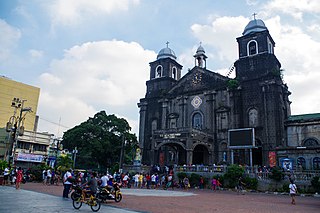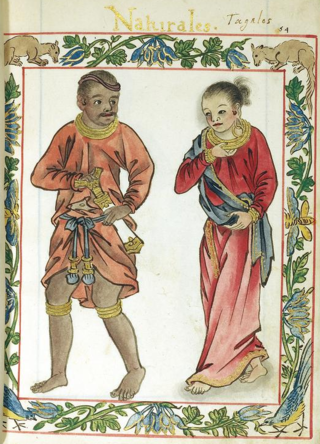Related Research Articles

Tondo is a district located in Manila, Philippines. It is the largest in terms of area and population of Manila's sixteen districts, with a Census-estimated 631,313 people in 2015 and consists of two congressional districts. It is also the second most densely populated district in the city.

The Laguna Copperplate Inscription is an official acquittance inscribed onto a copper plate in the Shaka year 822. It is the earliest known calendar-dated document found within the Philippine Islands.

Lumban, officially the Municipality of Lumban, is a 3rd class municipality in the province of Laguna, Philippines. It can reach this town Passing Through Rizal Province via Manila East Road or SLEX. According to the 2020 census, it has a population of 32,330 people.

The Kawi or Old Javanese script is a Brahmic script found primarily in Java and used across much of Maritime Southeast Asia between the 8th century and the 16th century. The script is an abugida meaning that characters are read with an inherent vowel. Diacritics are used, either to suppress the vowel and represent a pure consonant, or to represent other vowels.

Pulilan, officially the Municipality of Pulilan, is a 1st class municipality in the province of Bulacan, Philippines. According to the 2020 census, it has a population of 108,836 people.

Recent archaeological and other evidence suggests Hinduism has had some cultural, economic, political and religious influence in the Philippines. Among these is the 9th century Laguna Copperplate Inscription found in 1989, deciphered in 1992 to be Kawi script with Sanskrit words; the golden Agusan statue discovered in another part of Philippines in 1917 has also been linked to Hinduism.

In early Philippine history, the Tagalog settlement at Tondo was a major trade hub located on the northern part of the Pasig River delta, on Luzon island. Together with Maynila, the polity (bayan) that was also situated on the southern part of the Pasig River delta, had established a shared monopoly on the trade of Chinese goods throughout the rest of the Philippine archipelago, making it an established force in trade throughout Southeast Asia and East Asia.
Antoon Postma was a Dutch anthropologist who married into and lived among the Hanunuo, a Mangyan sub-tribe in southeastern Mindoro, Philippines. He is best known for being the first to decipher the Laguna Copperplate Inscription, and for documenting the Hanunó'o script, paving the way for its preservation and understanding.
Senapati is a title in ancient India denoting the rank of military commander or general of the army.

The known recorded history of the Philippines between 900 and 1565 begins with the creation of the Laguna Copperplate Inscription in 900 and ends with Spanish colonisation in 1565. The inscription records its date of creation in the year 822 of the Hindu Saka calendar, corresponding to 900 AD in the Gregorian system. Therefore, the recovery of this document marks the end of prehistory of the Philippines at 900 AD. During this historical time period, the Philippine archipelago was home to numerous kingdoms and sultanates and was a part of the theorised Indosphere and Sinosphere.
The nature of religion in the pre-colonial Philippines is often unclear. Religions present include animism, indigenous religious beliefs and mythologies such as Anito and influences from Hinduism and Buddhism. The earliest pieces of evidence that exist are archaeological finds including Hindu–Buddhist gold statues. The earliest written evidence comes from the Laguna Copperplate Inscription, dated to around 900 CE, which uses the Buddhist–Hindu lunar calendar. With the arrival of Islam in the 14th century, the older religions gradually disappeared, and after the arrival of Ferdinand Magellan in 1521 Christianity, specifically Roman Catholicism, became the dominant religion. However, some of the indigenous peoples of the Philippines continue to practice animism today, and many of the traditions in Anito have survived in the form of Folk Catholicism.

The history of Luzon covers events that happened in the largest island of the Philippine Archipelago, Luzon. Luzon wrested the record of having the oldest man ever discovered in the Philippines with discovery of the Callao Man in 2007, which predated the Tabon Man by around 20,000 years. The written history of Luzon began in around 900 AD with the discovery of the Laguna Copperplate Inscription in 1989. After that, Luzon began to appear in the annals of the Chinese and Japanese. One example would be the Ming Shilu, wherein Luzon appeared in 22 records. Luzon was split among Hindu-Buddhist kingdoms, Muslim principalities, and ethnoreligious tribes, who had trading connections with Borneo, Malaya, Java, Indochina, India, Okinawa, Japan and China before the Spanish established their rule. As a result of the Spanish–American War, Luzon became American territory. In the Second World War, Luzon saw one of the fiercest battles during the Japanese occupation. Luzon, apart from being the largest island, had been the economic and political center of the Philippines ever since the country entered the Western Calendar, being home to the country's capital city, Manila, and the country's largest metropolis, Metro Manila.

Jayadewa or Jayadeva was the name of the Lord Minister of Pailah at the time that the Laguna Copperplate Inscription was written in c. 900 CE. According to the document, he served as the representative of the "Commander in Chief" in pardoning the descendants of an individual named Namwaran of his debts. Although no other records describe his life and works, Jayadewa is an important figure in Philippine historiography because he is one of the persons clearly identified in the LCI, which is the earliest known written document found in the Philippines.
Old Tagalog, also known as Old Filipino, is the earliest form of the Tagalog language during the Classical period. It is the primary language of pre-colonial Tondo, Namayan and Maynila. The language originated from the Proto-Philippine language and evolved to Classical Tagalog, which was the basis for Modern Tagalog. Old Tagalog uses the Tagalog script or Baybayin, one of the scripts indigenous to the Philippines.
Malay is spoken by a minority of Filipinos, particularly in the Palawan, Sulu Archipelago and parts of Mindanao, mostly in the form of trade and creole languages, such as Sabah Malay.
Mount Diwata, colloquially nicknamed as Diwalwal, is a remote 1,261-metre (4,137 ft) high range of volcanic mountain and biodiversity area in Davao Region on eastern part of Mindanao island of Philippines. Rich in gold and copper ores and mines, it is spread across the 3 municipalities: (a) Monkayo in the province of Davao de Oro; as well as (b) Cateel and (c) Boston in the province of Davao Oriental. Laguna Copperplate Inscription, the oldest written document in Philippines dated to 900 CE, refers to Mount Diwata.

Binuangan is a barangay in the coastal municipality of Obando in Bulacan, the Philippines. It is an island on an estuary formed by the confluence of Binuangan River and Muzon River along the coast of Manila Bay, north of Isla Pulo, Tanza, Navotas. The barangay is surrounded by intertidal mudflats and sandbars with fish pens separating it from the mainland of Obando to the east. It is bordered by the barangays of Tawiran and Paco on the north, Lawa to the east, Salambao on the south, and the Bulakan barangay of Taliptip to the west. As of the 2020 census, Binuangan had a population of 5,045. Binuangan is an ancient barangay, mentioned in the earliest known document of the Philippines, the Laguna Copperplate Inscription in 900 AD.

The historiography of the Philippines includes historical and archival research and writing on the history of the Philippine archipelago including the islands of Luzon, Visayas, and Mindanao.
References
- ↑ Postma, Antoon (April–June 1992). "The Laguna Copper-Plate Inscription: Text and Commentary". Philippine Studies. Ateneo de Manila University. 40 (2): 182–203. JSTOR 42633308.
- ↑ Tiongson, Jaime F. (August 8, 2010). "Laguna Copperplate Inscription: A New Interpretation Using Early Tagalog Dictionaries". Bayang Pinagpala. Retrieved on 2011-11-18. Archived September 29, 2012, at the Wayback Machine